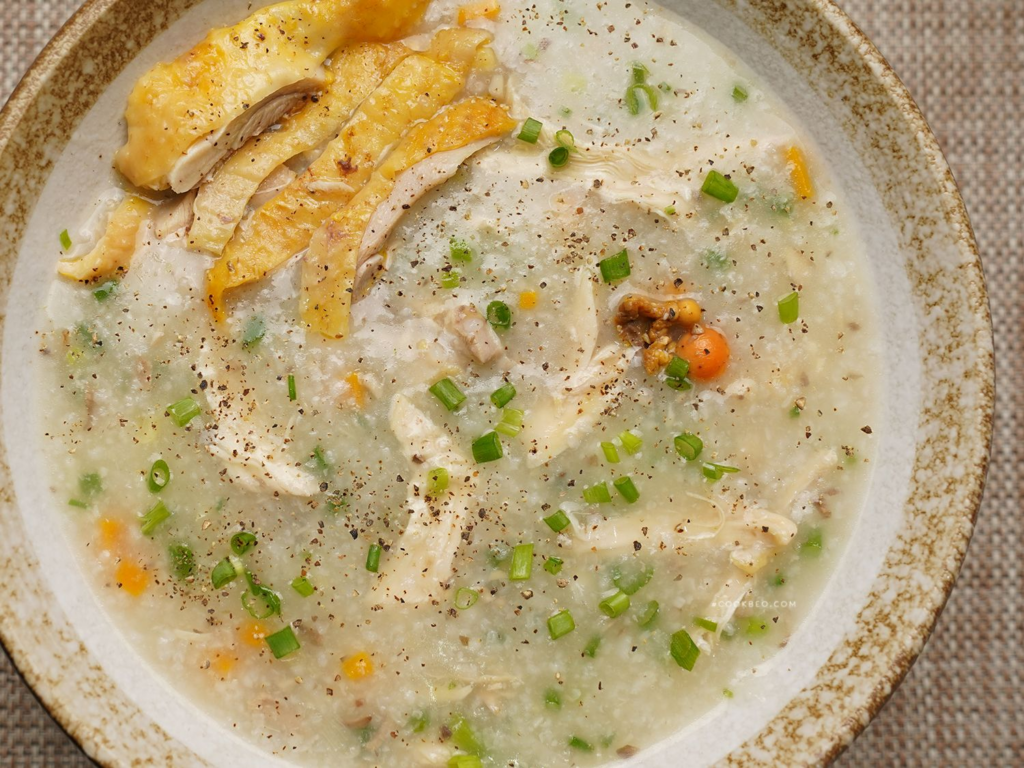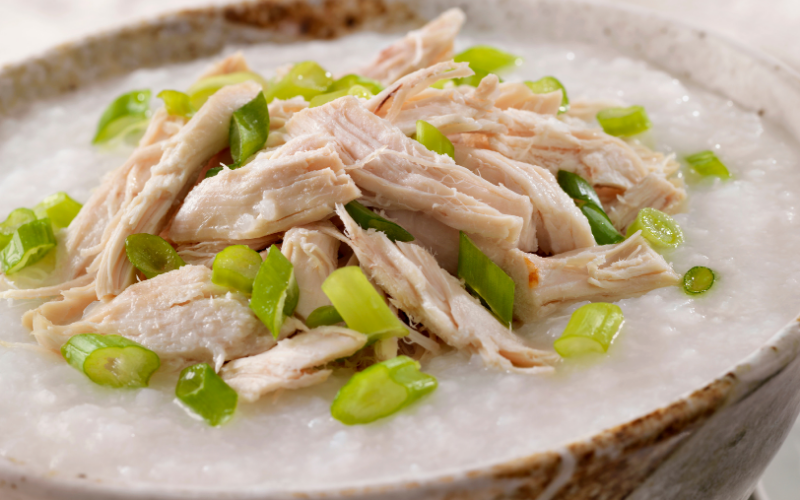When it comes to soul-warming and comforting dishes, few can rival the Vietnamese Chicken Rice Porridge, commonly known as Cháo Gà. This delectable dish has been a staple in Vietnamese cuisine for generations, known for its simplicity, nourishment, and soothing qualities.
Whether you are seeking a hearty breakfast, a revitalizing lunch, or a satisfying dinner, Cháo Gà is the perfect choice. In this blog post, we will take you on a gastronomic journey, exploring the history, ingredients, cooking process, and the cultural significance of this delightful dish.
The Origins and Cultural Significance of Cháo Gà

Cháo Gà holds a special place in Vietnamese culture, with its origins dating back centuries. Often considered a traditional home remedy for sickness and a source of comfort during cold seasons, Cháo Gà has become a symbol of care and nurturing in Vietnamese families. The process of preparing Cháo Gà is a labor of love, with each family adding its unique touch, making it a truly heartwarming and personal dish.
Ingredients for Cháo Gà

The beauty of Cháo Gà lies in its simplicity, as it requires just a few key ingredients to create a dish bursting with flavor. Here are the main components:
Chicken
The heart of Cháo Gà is tender, succulent chicken. Traditionally, bone-in chicken pieces or a whole chicken are used, imparting a richer taste to the broth.
Rice
The rice used in Cháo Gà is typically a short-grain variety, such as jasmine rice. The rice is thoroughly cooked until it breaks down and thickens the porridge, creating a smooth and creamy texture.
Ginger and Garlic
Ginger and garlic add aromatic undertones to the broth, infusing the Cháo Gà with a delightful fragrance.
Chicken Broth
A flavorful chicken broth serves as the base of the porridge, enhancing its taste and depth.
Fish Sauce
Fish sauce is a quintessential ingredient in Vietnamese cuisine, and its umami notes elevate the overall flavor of Cháo Gà.
Garnishes
Chopped green onions, cilantro, fried shallots, and a dash of black pepper are commonly used as garnishes to enhance the presentation and taste of the dish.
Cooking Cháo Gà: A Step-by-Step Guide

Preparing the Chicken
- Start by washing the chicken thoroughly under cold running water.
- Place the chicken in a large pot, and add enough water to cover it.
- Bring the water to a boil, then reduce the heat to a gentle simmer.
- Skim off any foam that rises to the surface during cooking.
- Add sliced ginger and crushed garlic to the pot, seasoning the broth with a pinch of salt and pepper.
- Allow the chicken to simmer until it is tender and fully cooked.
Cooking the Rice
- While the chicken is simmering, rinse the rice under cold water until the water runs clear.
- Once the chicken is cooked, remove it from the pot and set it aside.
- Pour the rice into the pot with the chicken broth.
- Stir the rice occasionally to prevent it from sticking to the bottom of the pot.
Shredding the Chicken
- Once the chicken has cooled down, shred the meat into bite-sized pieces using a fork or your fingers.
- Discard the bones and any excess skin.
Finishing the Cháo Gà
- As the rice cooks, it will gradually break down and thicken the porridge.
- Add fish sauce to taste, adjusting the seasoning as needed.
- Stir in the shredded chicken, allowing it to infuse with the rice porridge.
- Simmer the mixture until the desired consistency is achieved – the Cháo Gà should be smooth, creamy, and comforting.
Serving the Cháo Gà
- Ladle the Cháo Gà into individual serving bowls.
- Garnish each bowl with chopped green onions, cilantro, and fried shallots.
- A sprinkle of freshly ground black pepper adds a final touch of flavor.
Health Benefits of Cháo Gà

Serving Size: 1 bowl (approximately 1 cup)
Calories: 200-250 calories
Macronutrients:
- Protein: 15-20g
- Carbohydrates: 25-30g
- Fat: 5-8g
Vitamins and Minerals:
- Vitamin A: 500-1000 IU (International Units)
- Vitamin C: 5-10 mg
- Calcium: 30-50 mg
- Iron: 1-2 mg
- Potassium: 200-300 mg
- Phosphorus: 150-200 mg
Dietary Fiber: 1-2g
Cholesterol: 30-50 mg
Sodium: 500-800 mg (Note: The sodium content may vary based on the amount of added salt or fish sauce.)
Variations and Serving Suggestions
Cháo Gà with Century Eggs (Cháo Gà Trứng Thơm): For a unique twist, add sliced century eggs to the Cháo Gà. Century eggs, also known as preserved eggs, have a distinct flavor that complements the creamy porridge.
Cháo Gà with Mushrooms (Cháo Gà Nấm): Enhance the texture and flavor by adding a variety of sliced mushrooms, such as shiitake or oyster mushrooms, to the Cháo Gà. The earthy taste of mushrooms complements the comforting broth.
Cháo Gà with Abalone (Cháo Gà Bào Ngư): Elevate the indulgence of Cháo Gà by incorporating tender, thinly sliced abalone. The delicate taste of abalone pairs harmoniously with the creamy rice porridge.
Cháo Gà with Poached Eggs (Cháo Gà Trứng Luộc): If you prefer a different egg option, add poached eggs to your Cháo Gà. The soft, runny yolk adds richness and depth to the dish.
Cháo Gà with Lemongrass (Cháo Gà Xả): Infuse the broth with the aromatic flavor of lemongrass by simmering the herb along with the chicken. Lemongrass adds a refreshing and zesty element to the Cháo Gà.
Other Vietnamese Chicken Recipes
Cháo Gà is incredibly versatile, and regional variations can be found throughout Vietnam. Some common variations include:
Chicken Pho (Pho Ga) Recipe: A delightful spin on the traditional beef Pho, this chicken version brings all the comforting flavors in a bowl.
Bun Ga Nuong (Vietnamese Grilled Chicken Noodle Salad) Recipe: For a refreshing and light meal, try this grilled chicken noodle salad, perfect for warm days.
Mien Ga Recipe: If you prefer glass noodles, this recipe is an excellent option to diversify your culinary experiences.
Ga Roti Recipe: Indulge in tender chicken roasted to perfection with this mouthwatering Ga Roti recipe.
Chicken Banh Mi Recipe: For a delightful sandwich option, explore this Vietnamese classic with succulent chicken.
Cari Ga: Experience the fusion of Vietnamese and Indian flavors in this aromatic chicken curry.
Ga Kho Gung: This ginger-infused chicken dish will entice your taste buds with its unique blend of flavors.
Chicken Salad with Mangosteen Recipe: For a burst of exotic sweetness, try this salad with the tropical fruit, mangosteen.
FAQs
Can I use different types of rice for Cháo Gà?
While short-grain rice like jasmine rice is traditionally used for Cháo Gà, you can experiment with other varieties like sticky rice or even brown rice for added nutrition and texture variations.
Are there regional variations of Cháo Gà in Vietnam?
Yes, like many traditional dishes, Cháo Gà may have regional variations across Vietnam. Different regions may use unique herbs, spices, or additional ingredients to personalize the flavor profile of the dish.
Can I make Cháo Gà using leftover chicken?
Certainly! Cháo Gà is an excellent dish to utilize leftover cooked chicken. Simply shred the cooked chicken and add it to the rice porridge during the final stages of cooking to infuse the flavors.
Can I freeze leftover Cháo Gà for later consumption?
Yes, you can freeze leftover Cháo Gà in airtight containers for later consumption. When reheating, you may need to add some water or broth to adjust the consistency as it can thicken when refrigerated or frozen.
Is Cháo Gà gluten-free?
Yes, Cháo Gà is naturally gluten-free as it primarily consists of rice, chicken, and herbs. However, it’s essential to check the ingredients in the chicken broth and fish sauce used to ensure they are gluten-free as well.
Conclusion
In Vietnamese cuisine, Cháo Gà embodies the spirit of comfort and nourishment. Its simplicity, rich flavors, and cultural significance make it a beloved dish for people of all ages. Whether you enjoy it as a remedy for a cold or simply to warm your soul, Cháo Gà offers an unforgettable culinary experience that will leave you craving for more.
So, the next time you seek comfort in a bowl of wholesome goodness, consider trying your hand at preparing Vietnamese Chicken Rice Porridge – a delightful journey through the heart and soul of Vietnam’s culinary heritage. Bon appétit!